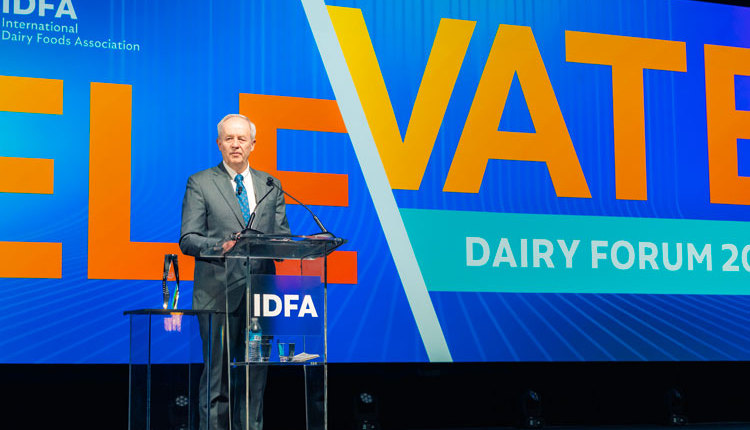In 2009, the U.S. began to truly enter the arena of global dairy marketing. Since this time, an ever-growing share of U.S. milk has been exported in some form. Our export volume has risen from 2 percent in 2000 to beyond 10 percent in 2013.
 "A shifting focus on international markets will provide an opportunity for our industry's continued growth, but it will not be without challenges," noted Tim Hunt, Global Dairy Strategist with Rabobank.
"A shifting focus on international markets will provide an opportunity for our industry's continued growth, but it will not be without challenges," noted Tim Hunt, Global Dairy Strategist with Rabobank.
"There is a good dairy marketplace in the U.S. but it is not as good as it used to be," he continued. This is easily observed with the nation's trend continually declining per capita consumption of fluid milk.
There has been a change in the way dairy and milk commodity prices behave. Pricing is influenced by what goes on outside of our borders. The three-year cyclicity of milk pricing will go by the wayside.
To take advantage of these international opportunities, planning is required. This is not an opportunity that will drop into our laps – we have to prepare.
Exports, primarily of milk powder, whey and cheese, have continued to rise in recent years. We are neck and neck with New Zealand to overtake its role as the second largest dairy product exporter. The European Union holds the top spot for total export volume.
Where are we now?
Dairy commodity prices hit record levels in April in a range of product categories (whole milk powder, skim milk powder, butter and so forth).
This was not a demand driven rally though. Often price booms mirroring what happened in April are tied to record levels of GDP growth. This recent price surge was linked to a GDP growing at a mere 3 percent.
In addition to this consumption worldwide, and especially in developed nations, is falling. The European Union consumes 20 percent of global milk production; the continent is currently consuming less dairy than it did 12 months ago. Combined, the European Union and the United States consume 35 percent of the world's dairy production. The market in these two regions is flat.
Despite this marked decline, some product categories are doing well. Greek yogurt consumption is rising. With a zero fat, high protein product in a larger package, Chobani was able to take yogurt from accompanying the meal to being a standalone, recognized for its satiety.
In 2013, GDP growth is 3 percent, yet whole milk powder prices have been driven to $6,000 per ton. International buyers have few opportunities to purchase product from other countries. In turn, they have turned to the U.S. for powder, skyrocketing its values. U.S. cheese prices have weakened as a result of this.
To learn more about Milk Pricing and Production, follow the link.

The author, Amanda Smith, was an associate editor and is an animal science graduate of Cornell University. Smith covers feeding, milk quality and heads up the World Dairy Expo Supplement. She grew up on a Medina, N.Y., dairy, and interned at a 1,700-cow western New York dairy, a large New York calf and heifer farm, and studied in New Zealand for one semester.
 "A shifting focus on international markets will provide an opportunity for our industry's continued growth, but it will not be without challenges," noted Tim Hunt, Global Dairy Strategist with Rabobank.
"A shifting focus on international markets will provide an opportunity for our industry's continued growth, but it will not be without challenges," noted Tim Hunt, Global Dairy Strategist with Rabobank. "There is a good dairy marketplace in the U.S. but it is not as good as it used to be," he continued. This is easily observed with the nation's trend continually declining per capita consumption of fluid milk.
There has been a change in the way dairy and milk commodity prices behave. Pricing is influenced by what goes on outside of our borders. The three-year cyclicity of milk pricing will go by the wayside.
To take advantage of these international opportunities, planning is required. This is not an opportunity that will drop into our laps – we have to prepare.
Exports, primarily of milk powder, whey and cheese, have continued to rise in recent years. We are neck and neck with New Zealand to overtake its role as the second largest dairy product exporter. The European Union holds the top spot for total export volume.
Where are we now?
Dairy commodity prices hit record levels in April in a range of product categories (whole milk powder, skim milk powder, butter and so forth).
This was not a demand driven rally though. Often price booms mirroring what happened in April are tied to record levels of GDP growth. This recent price surge was linked to a GDP growing at a mere 3 percent.
In addition to this consumption worldwide, and especially in developed nations, is falling. The European Union consumes 20 percent of global milk production; the continent is currently consuming less dairy than it did 12 months ago. Combined, the European Union and the United States consume 35 percent of the world's dairy production. The market in these two regions is flat.
Despite this marked decline, some product categories are doing well. Greek yogurt consumption is rising. With a zero fat, high protein product in a larger package, Chobani was able to take yogurt from accompanying the meal to being a standalone, recognized for its satiety.
In 2013, GDP growth is 3 percent, yet whole milk powder prices have been driven to $6,000 per ton. International buyers have few opportunities to purchase product from other countries. In turn, they have turned to the U.S. for powder, skyrocketing its values. U.S. cheese prices have weakened as a result of this.
To learn more about Milk Pricing and Production, follow the link.

The author, Amanda Smith, was an associate editor and is an animal science graduate of Cornell University. Smith covers feeding, milk quality and heads up the World Dairy Expo Supplement. She grew up on a Medina, N.Y., dairy, and interned at a 1,700-cow western New York dairy, a large New York calf and heifer farm, and studied in New Zealand for one semester.










